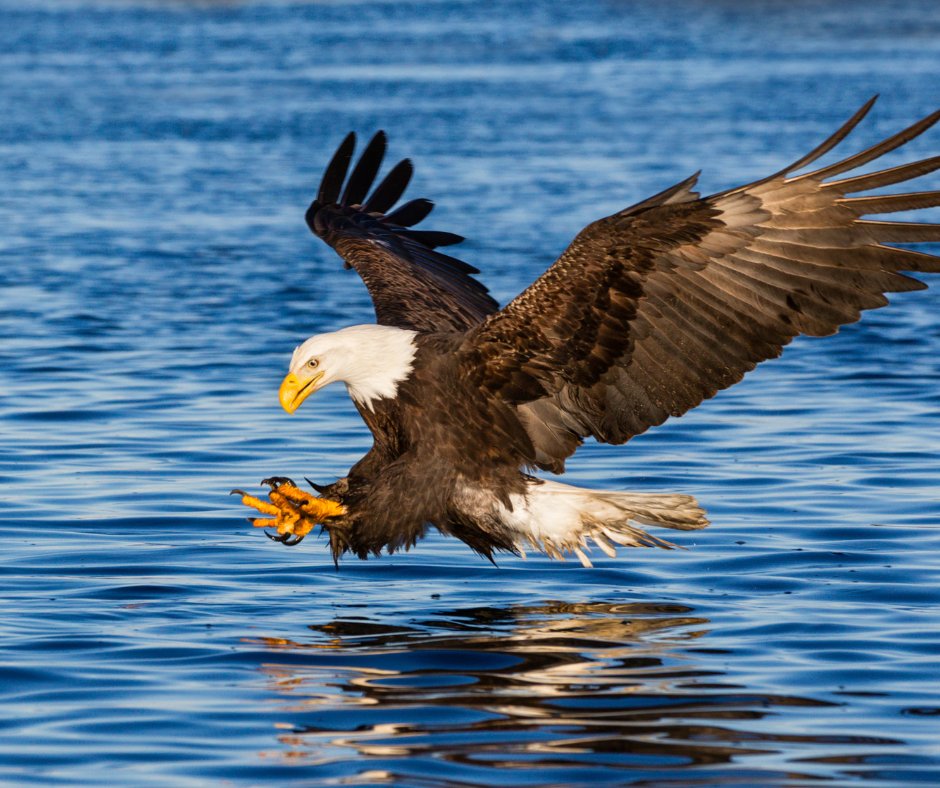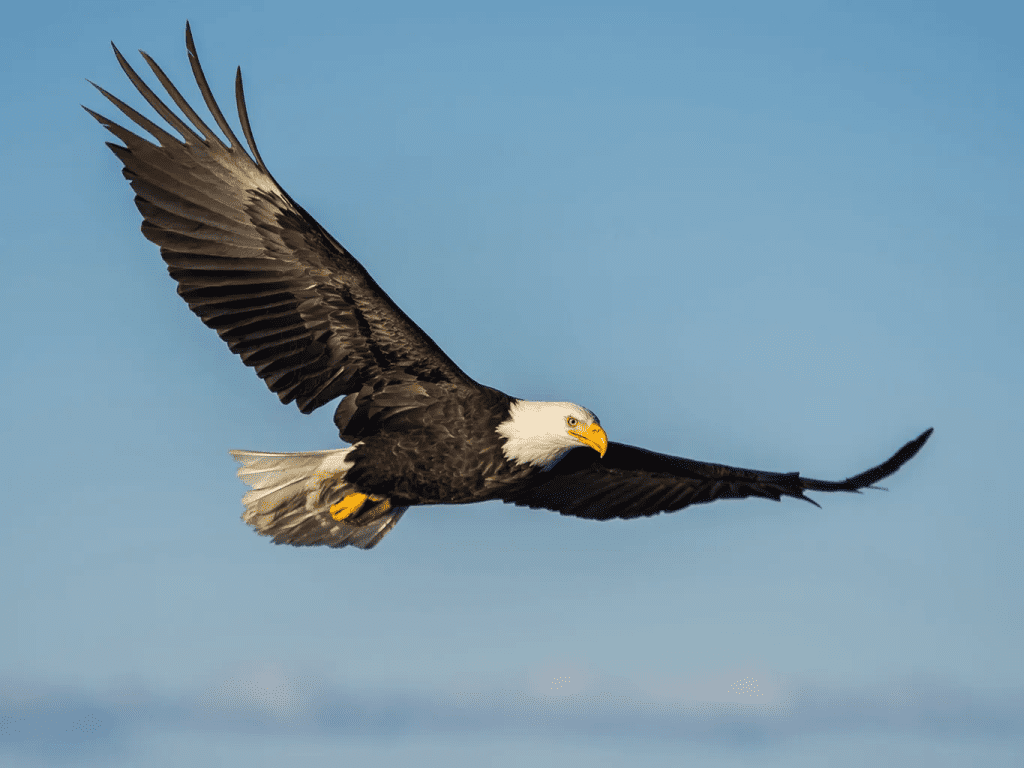Ever wondered how an eagle can swoop down from the sky and snatch a fish right out of the water with flawless precision? It’s not just skill — it’s next-level eyesight. Eagles are like flying cameras, equipped with ultra-high-definition vision that puts modern drone tech to shame.
These majestic birds don’t just glide through the air — they hunt with purpose. Their eyes are designed for the skies, and when you learn just how powerful their vision really is, it’s hard not to be amazed.
Eagle Vision: Better Than 20/20

Most humans consider 20/20 vision to be perfect. But eagles? They blow that out of the water.
Eagles are believed to have 20/5 vision, meaning they can see from 20 feet away what a human would only see clearly at 5 feet. That’s four times sharper than our best natural vision. This insane clarity allows them to pick up details we’d miss entirely — like a small fish flicking near the surface of a river, all from hundreds of feet in the air.
Imagine being able to spot a coin on the ground while standing on top of a 10-story building — that’s the eagle’s world.
Glare? Not a Problem for Eagles
Now, let’s talk about water. Even on a sunny day, the surface of a lake or river can be like a mirror — filled with glare and reflection. For us, it’s tough to see past it. But for eagles?
Their eyes are naturally equipped to filter out glare. They have a special structure in their retina that reduces the interference caused by reflected light, allowing them to cut through brightness and focus on movement beneath the surface. It’s like wearing polarized sunglasses — except built-in, and way more advanced.
Video : The Incredible Eyesight of Eagles: Nature’s Sharpest Vision
So while we might squint at a shiny lake, an eagle is already locked on to lunch.
Binocular Vision That Tracks Targets Mid-Air
You’ve probably heard the term “binocular vision” before — it’s what allows animals (and humans) to judge distance. Eagles have this too, but with a supercharged twist.
Their eyes face slightly forward, giving them excellent depth perception. And because they can move their heads smoothly while keeping their eyes locked on a target, they maintain laser focus even during high-speed dives. That means they can:
- Track a moving fish
- Calculate the angle of attack
- Time their dive to the millisecond
No second guesses. No hesitation. Just pure precision.
A Wide-Angle Field of View Without Losing Detail
Another wild fact? Eagles have a field of view of about 340 degrees — nearly a full circle. Yet somehow, they manage to maintain pinpoint detail in their central vision.
Their retinas are loaded with cone cells, which detect fine details and colors. This gives them a massive advantage: they can scan a huge area while simultaneously zooming in on one moving object. It’s like having both a panoramic lens and a telephoto lens active at the same time.
While you’re blinking at a blurry bird in the sky, the eagle already sees you — and probably knows what brand of hat you’re wearing.
How Eagles Use Vision to Hunt

Let’s break it down. Picture an eagle flying 300 feet above a river. It’s calm, quiet, and the water’s shimmering. Then, with almost no warning, the eagle changes course. Its wings pull in tight, and it drops like a missile.
Why? Because its eyes just caught a tiny flash beneath the surface — a fish swimming near the top.
The eagle:
- Adjusts its position mid-flight
- Times its dive perfectly
- Uses its talons to grab the fish — often without getting fully wet
This all happens in seconds. And it all begins with a flash of movement that you and I wouldn’t even notice.
Evolution Built the Ultimate Predator’s Eye
Eagles didn’t just wake up one day with superhero vision. This visual power is the result of millions of years of evolution, fine-tuned for survival.
Their eyesight helps them:
- Hunt more efficiently
- Avoid threats
- Navigate wide territories with ease

In the wild, vision is survival, and eagles have mastered that art. From open skies to dense forests, they rely on their vision more than anything else. It’s their secret weapon — and honestly, their superpower.
How Eagles Compare to Human Technology
Think your 4K drone is impressive? Eagles would laugh — if they could.
While drones rely on lenses and software to zoom and focus, eagles do it naturally and in real-time. No battery required. No GPS lag. Just pure instinct and biological design.
Their eyes offer:
- Superior motion detection
- Real-time tracking
- Optical clarity beyond anything man-made
In fact, researchers studying eagle vision have helped inspire improvements in camera lenses, tracking systems, and even augmented reality.
Why It All Matters: Nature’s Design Is Still Unmatched
Eagles remind us of something powerful — nature still does it better. We’ve created incredible tools and gadgets, but the eagle’s eye shows that evolution’s been doing high-tech for much longer.
Video : Just How Good is Eagle Vision?
Next time you see one soaring in the sky, take a moment. You’re looking at a living, breathing marvel — one that can see better, move faster, and hunt smarter than any drone or AI-powered camera.
Conclusion: Eyes on the Skies
Eagles aren’t just symbols of power — they’re visual masters of the natural world. With vision four times sharper than ours, built-in glare filters, and targeting precision that feels almost mechanical, they dominate the skies like no other.
Their eyes are their greatest weapon — and their greatest gift.
So, the next time you see an eagle circling high above, remember: it sees you… in more detail than you’ll ever see it. And that’s not magic — that’s evolution in high definition.
Think your eyes are sharp? Nature’s got you beat — try spotting a fish from 300 feet up.
A controversial statement made by an online influencer is that she is “too pretty” to work for the rest of her life.

With a recent TikTok post, well-known influencer Lucy Welcher, who has a sizable online following, started a social media firestorm. The dispute? Welcher said she is “too pretty” to work in a conventional setting.

The Influencer’s Backlash and the Go-Viral Video
Welcher, who is well-known for her opulent lifestyle videos, expressed her dislike of working a regular nine to five job in the now-deleted video. She bemoaned the thought of having to get up early every day and asked herself if her attractive appearance was a match for the grind. Many viewers found offense at this careless comment.

The influencer received a lot of backlash for her post. Welcher came under fire from commenters for being conceited and superficial. They emphasized the value of having a strong work ethic and the erroneous belief that someone’s beauty should absolve them of social responsibility. A user satirically pointed out Welcher’s conceited sense of importance, while another drew attention to the discrepancy between work ethic and attractiveness.
Welcher tried to douse the fires when he saw the outcry. She said she was being unfairly targeted, so she removed the old video and uploaded a new one. She answered online accusations about her lifestyle with a sarcastic response. She refuted rumors that she lived in a home, had expensive automobiles, or earned enormous sums of money.
A Second Opinion: Comedy or Ongoing Debate?
A few days later, Welcher uploaded a “remake” of the original video, as if reveling in the publicity. This time, some viewers took her words as a joke, which resulted in a more positive response. Supporters flocked to the influencer’s defense; some even jokingly agreed with the idea that one’s beauty serves as an excuse to avoid work.
Reimagining of the most despised video I’ve ever created: #SephoraGiveOrKeep #workable #funny
The difficulties with humor on social media are made clear by this episode. Welcher’s initial video didn’t go well because it lacked context. The incident serves as a reminder of how easily messages can be misconstrued while communicating online, emphasizing the importance of being explicit in all communications, even when comedy is included.
Part of this information was produced using a language model from artificial intelligence. Please be aware that although we work hard to ensure quality and authenticity, the information supplied might not be perfect or current. For specialized guidance or information, we advise contacting experts and conducting your own independent verification of the content. We disclaim all liability and responsibility for how this content is used or interpreted.



Leave a Reply